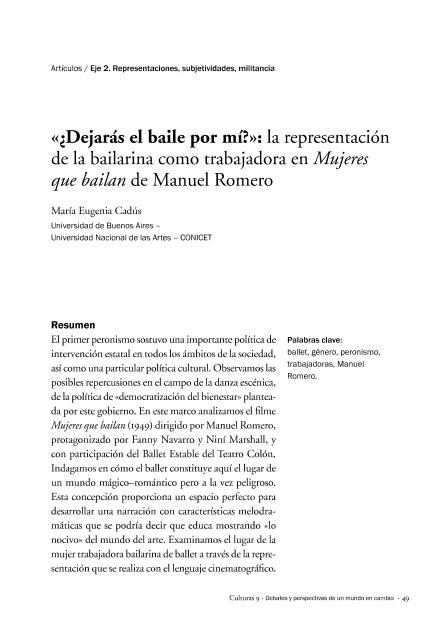Mostrar el registro sencillo del ítem
dc.contributor.author
Cadús, María Eugenia

dc.date.available
2020-07-31T18:27:30Z
dc.date.issued
2015-03
dc.identifier.citation
Cadús, María Eugenia; «¿Dejarás el baile por mí?»: la representación de la bailarina como trabajadora en Mujeres que bailan de Manuel Romero; Universidad Nacional del Litoral; Culturas; 9; 3-2015; 49-65
dc.identifier.issn
1515-3738
dc.identifier.uri
http://hdl.handle.net/11336/110671
dc.description.abstract
El primer peronismo sostuvo una importante política de intervención estatal en todos los ámbitos de la sociedad, así como una particular política cultural. Observamos las posibles repercusiones en el campo de la danza escénica, de la política de «democratización del bienestar» planteada por este gobierno. En este marco analizamos el filme Mujeres que bailan (1949) dirigido por Manuel Romero, protagonizado por Fanny Navarro y Niní Marshall, y con participación del Ballet Estable del Teatro Colón. Indagamos en cómo el ballet constituye aquí el lugar de un mundo mágico–romántico pero a la vez peligroso. Esta concepción proporciona un espacio perfecto para desarrollar una narración con características melodramáticas que se podría decir que educa mostrando «lo nocivo» del mundo del arte. Examinamos el lugar de la mujer trabajadora bailarina de ballet a través de la representación que se realiza con el lenguaje cinematográfico.
dc.description.abstract
In its first two terms, the administration of Argentine President Juan Domingo Perón set forth a cultural project that mirrored its signature «welfare democratization» state policy, focused on expanding social welfare programs. The government promoted access, until then very limited, of the popular sectors to the arts, culture, tourism, education, and leisure. Such an expansion of the working classes’ cultural consumption challenged the standard definition of so–called «high» culture opposite «popular/mass» culture. This paper examines the film Mujeres que bailan (1949) directed by Manuel Romero, starring Fanny Navarro and Niní Marshall, with the participation of Colón Theater Ballet. I focus on how ballet is represented in the melodramatic narration as a magic and romantic world that is attractive but dangerous at the same time, and on the fact that it educates the audience showing the «harmful» aspect of the art. Within this framework, I examine the role of ballerinas as women workers through cinematographic language.
dc.format
application/pdf
dc.language.iso
spa
dc.publisher
Universidad Nacional del Litoral
dc.rights
info:eu-repo/semantics/openAccess
dc.rights.uri
https://creativecommons.org/licenses/by-nc-sa/2.5/ar/
dc.subject
BALLET
dc.subject
GÉNERO
dc.subject
PERONISMO
dc.subject
TRABAJADORAS
dc.subject
MANUEL ROMERO
dc.subject.classification
Estudios sobre Cine, Radio y Televisión

dc.subject.classification
Arte

dc.subject.classification
HUMANIDADES

dc.subject.classification
Arte, Historia del Arte

dc.subject.classification
Arte

dc.subject.classification
HUMANIDADES

dc.subject.classification
Artes escénicas

dc.subject.classification
Arte

dc.subject.classification
HUMANIDADES

dc.title
«¿Dejarás el baile por mí?»: la representación de la bailarina como trabajadora en Mujeres que bailan de Manuel Romero
dc.type
info:eu-repo/semantics/article
dc.type
info:ar-repo/semantics/artículo
dc.type
info:eu-repo/semantics/publishedVersion
dc.date.updated
2020-07-31T14:19:34Z
dc.journal.number
9
dc.journal.pagination
49-65
dc.journal.pais
Argentina

dc.journal.ciudad
Santa Fé
dc.description.fil
Fil: Cadús, María Eugenia. Universidad de Buenos Aires. Facultad de Filosofía y Letras; Argentina. Universidad Nacional de Las Artes. Departamento de Artes del Movimiento "maria Ranuova". Instituto de Investigación de Las Artes del Movimiento; Argentina. Consejo Nacional de Investigaciones Científicas y Técnicas; Argentina
dc.journal.title
Culturas
Archivos asociados
